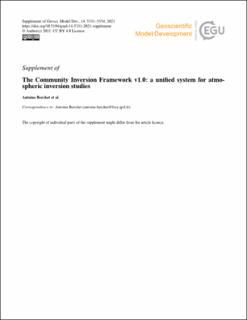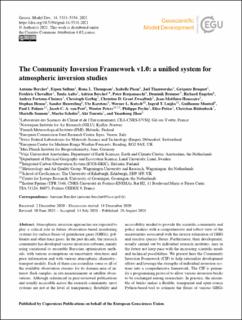| dc.contributor.author | Berchet, Antoine | |
| dc.contributor.author | Sollum, Espen | |
| dc.contributor.author | Thompson, Rona Louise | |
| dc.contributor.author | Pison, Isabelle | |
| dc.contributor.author | Thanwerdas, Joel | |
| dc.contributor.author | Broquet, Grégoire | |
| dc.contributor.author | Chevallier, Frédéric | |
| dc.contributor.author | Aalto, Tuula | |
| dc.contributor.author | Berchet, Adrien | |
| dc.contributor.author | Bergamaschi, Peter | |
| dc.contributor.author | Brunner, Dominik | |
| dc.contributor.author | Engelen, Richard | |
| dc.contributor.author | Fortems-Cheiney, Audrey | |
| dc.contributor.author | Gerbig, Christoph | |
| dc.contributor.author | Zwaaftink, Christine Groot | |
| dc.contributor.author | Haussaire, Jean-Matthieu | |
| dc.contributor.author | Henne, Stephan | |
| dc.contributor.author | Houweling, Sanne | |
| dc.contributor.author | Karstens, Ute | |
| dc.contributor.author | Kutsch, Werner L. | |
| dc.contributor.author | Luijkx, Ingrid T. | |
| dc.contributor.author | Monteil, Guillaume | |
| dc.contributor.author | Palmer, Paul I. | |
| dc.contributor.author | van Peet, Jacob C. A. | |
| dc.contributor.author | Peters, Wouter | |
| dc.contributor.author | Peylin, Philippe | |
| dc.contributor.author | Potier, Elise | |
| dc.contributor.author | Rödenbeck, Christian | |
| dc.contributor.author | Saunois, Marielle | |
| dc.contributor.author | Scholze, Marko | |
| dc.contributor.author | Tsuruta, Aki | |
| dc.contributor.author | Zhao, Yuanhong | |
| dc.date.accessioned | 2021-09-14T14:15:18Z | |
| dc.date.available | 2021-09-14T14:15:18Z | |
| dc.date.created | 2021-09-10T12:48:23Z | |
| dc.date.issued | 2021 | |
| dc.identifier.citation | Geoscientific Model Development. 2021, 14, 5331-5354. | en_US |
| dc.identifier.issn | 1991-959X | |
| dc.identifier.uri | https://hdl.handle.net/11250/2776532 | |
| dc.description.abstract | Atmospheric inversion approaches are expected to play a critical role in future observation-based monitoring systems for surface fluxes of greenhouse gases (GHGs), pollutants and other trace gases. In the past decade, the research community has developed various inversion software, mainly using variational or ensemble Bayesian optimization methods, with various assumptions on uncertainty structures and prior information and with various atmospheric chemistry–transport models. Each of them can assimilate some or all of the available observation streams for its domain area of interest: flask samples, in situ measurements or satellite observations. Although referenced in peer-reviewed publications and usually accessible across the research community, most systems are not at the level of transparency, flexibility and accessibility needed to provide the scientific community and policy makers with a comprehensive and robust view of the uncertainties associated with the inverse estimation of GHG and reactive species fluxes. Furthermore, their development, usually carried out by individual research institutes, may in the future not keep pace with the increasing scientific needs and technical possibilities. We present here the Community Inversion Framework (CIF) to help rationalize development efforts and leverage the strengths of individual inversion systems into a comprehensive framework. The CIF is primarily a programming protocol to allow various inversion bricks to be exchanged among researchers. In practice, the ensemble of bricks makes a flexible, transparent and open-source Python-based tool to estimate the fluxes of various GHGs and reactive species both at the global and regional scales. It will allow for running different atmospheric transport models, different observation streams and different data assimilation approaches. This adaptability will allow for a comprehensive assessment of uncertainty in a fully consistent framework. We present here the main structure and functionalities of the system, and we demonstrate how it operates in a simple academic case. | en_US |
| dc.language.iso | eng | en_US |
| dc.rights | Navngivelse 4.0 Internasjonal | * |
| dc.rights.uri | http://creativecommons.org/licenses/by/4.0/deed.no | * |
| dc.title | The Community Inversion Framework v1.0: a unified system for atmospheric inversion studies | en_US |
| dc.type | Peer reviewed | en_US |
| dc.type | Journal article | en_US |
| dc.description.version | publishedVersion | en_US |
| dc.rights.holder | © Author(s) 2021. | en_US |
| dc.source.pagenumber | 5331-5354 | en_US |
| dc.source.volume | 14 | en_US |
| dc.source.journal | Geoscientific Model Development | en_US |
| dc.identifier.doi | 10.5194/gmd-14-5331-2021 | |
| dc.identifier.cristin | 1933251 | |
| dc.relation.project | EC/H2020/776810 | en_US |
| dc.relation.project | NILU - Norsk institutt for luftforskning: 118014 | en_US |
| cristin.ispublished | true | |
| cristin.fulltext | original | |
| cristin.fulltext | original | |
| cristin.qualitycode | 2 | |


